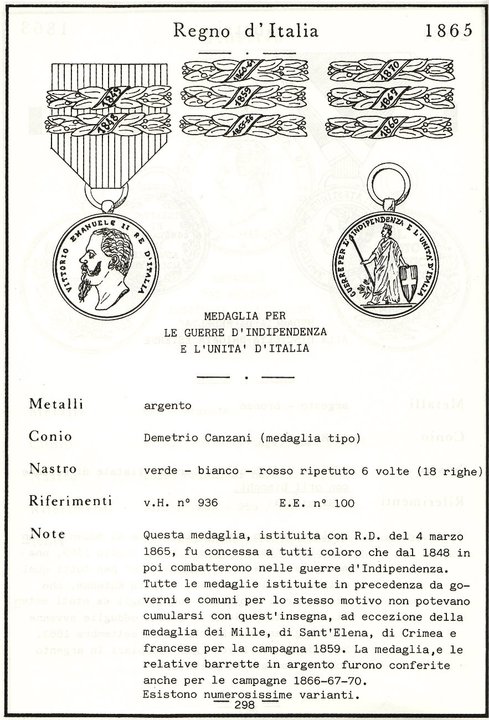Uno degli ultimi arrivi in collezione su storie e foto.
Le medaglia in oggetto è d'argento, ha un diametro di 32 mm e il nastrino è del classico tricolore italiano ripetuto per 6 volte.
L'incisore in questo caso fu Demetrio Canzani, ne esistono almeno 20 varianti, le più comuni sono Stefano Jonshon di Milano e Ferraris, inoltre si ha traccia di una variante di produzione privata francese molto rara incisa da E. Falot.
Venne istituita con regio decreto del 4 marzo 1865 e conferita a tutti i combattenti che parteciparono alle guerre d'indipendenza dal 1848 in poi, inoltre servì anche a rimuovere le svariate medaglie che vennero create dai singoli comuni.
Le notizie storiche sono prese dal libro "Le medaglie italiane degli ultimi 200 anni" del Brambilla.
Nei miei giri mi sono imbattuto anche in medaglie con lo stesso conio e nastrino ma non in argento. A dire dei venditori sono originali anche queste ma non mi sono mai fidato anche perchè a volte viene chiesto un prezzo più alto che per quelle in classiche. E' una medaglia non molto rara e si trova comunemente intorno ai 60-70 € senza barrette, qualcosa in più se sono presenti.
Se ne trovano molte con nastrini non originali, tenete presente che un nastrino, per bene che sia stato conservato, dopo più di 150 anni un minimo si sarà scolorito e consumato come potete vedere nella foto sottostante.
Particolare dell'incisore.
One of the latest arrivals in the collection of stories and photos.
Medal awarded to a fighter who took part in the campaign of 1849 (War of Independence) bar that displays the date that year. We are at the beginning of the events that led to the unification of Italy.
The medal object is silver, has a diameter of 32 mm, and the ribbon is of the classic Italian tricolor repeated for 6 times.
The engraver in this case was Demetrius Canzani, there are at least 20 variants, the most common are Jonshon and Stefano Ferraris, also there are traces of a variant of French private production very rare engraved by E. Falot.
It was established by the Royal Decree of 4 March 1865, and given to all the fighters who participated in the wars of independence since 1848, also served to remove a number of medals that were created by individual municipalities.
The historical data are taken from the book "The Italian medals of the last 200 years," the Brambilla.
I've also seen the same issue and medals with ribbon but not silver. For sellers these are original but I've never trusted because it is sometimes also called for a higher price than for those classics. The medal is not very rare and is commonly found around 60-70 € without bars, a little more if they are present.
They are found in many ribbons are not original, keep in mind that a ribbon for good that has been maintained, after more than 150 years a minimum you will be
discolored and worn as you can see in the picture below.
Medal awarded to a fighter who took part in the campaign of 1849 (War of Independence) bar that displays the date that year. We are at the beginning of the events that led to the unification of Italy.
The medal object is silver, has a diameter of 32 mm, and the ribbon is of the classic Italian tricolor repeated for 6 times.
The engraver in this case was Demetrius Canzani, there are at least 20 variants, the most common are Jonshon and Stefano Ferraris, also there are traces of a variant of French private production very rare engraved by E. Falot.
It was established by the Royal Decree of 4 March 1865, and given to all the fighters who participated in the wars of independence since 1848, also served to remove a number of medals that were created by individual municipalities.
The historical data are taken from the book "The Italian medals of the last 200 years," the Brambilla.
I've also seen the same issue and medals with ribbon but not silver. For sellers these are original but I've never trusted because it is sometimes also called for a higher price than for those classics. The medal is not very rare and is commonly found around 60-70 € without bars, a little more if they are present.
They are found in many ribbons are not original, keep in mind that a ribbon for good that has been maintained, after more than 150 years a minimum you will be
discolored and worn as you can see in the picture below.






Nessun commento:
Posta un commento